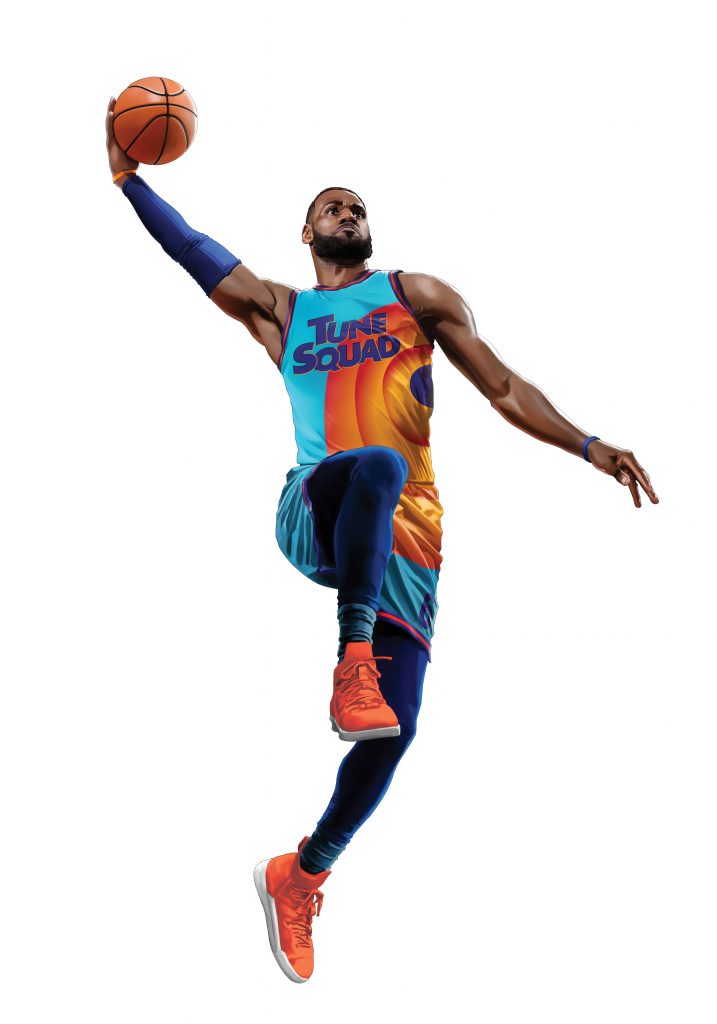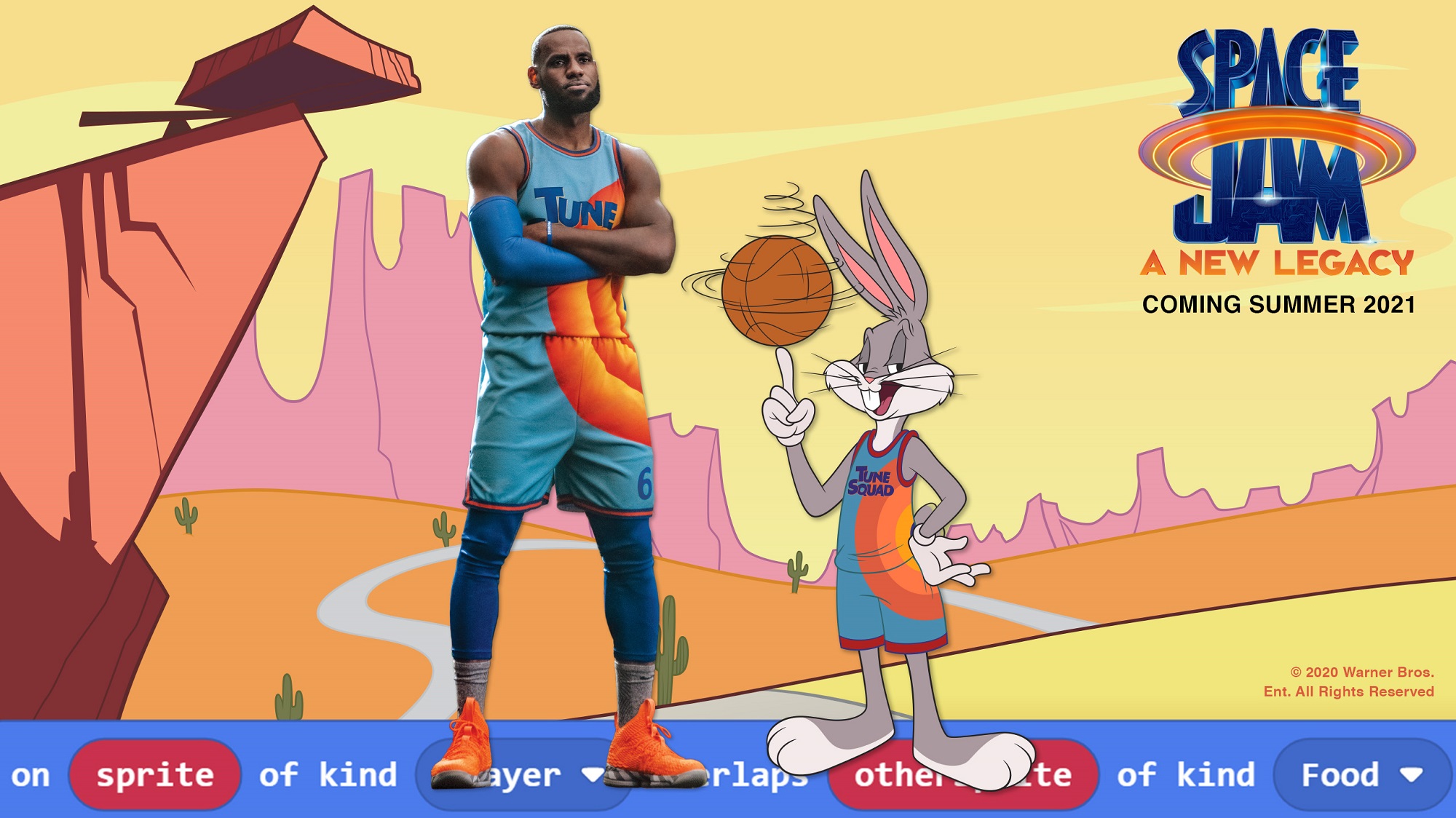
LeBron James, Bugs Bunny and ‘Space Jam: A New Legacy’ shoot for a new generation of students through basketball-inspired coding programs
There are few slam dunks in life, but it seems like a good bet when you pair a global icon like LeBron James with a campaign to inspire more interest in computer science.
Video games are enormously popular all over the world, as is basketball. While it may take a lot to become a star in the latter, people may not always realize the work that goes on behind-the-scenes to make video games – or that there are several paths to turning something they love (the former) into a career.
Microsoft Stores trainer-led workshops, as well as Microsoft MakeCode and Microsoft Learn on-demand lessons, present new and free opportunities in which learners of all ages in the U.S. and abroad can learn basic and advanced coding, create their own games and find out how to incorporate problem solving, perseverance and other skills into their lives – using basketball as the common element in drawing in new coders.
Launching Dec. 14, these new resources coincide with the announcement of an Xbox partnership with Warner Bros. on “Space Jam: A New Legacy,” where fans will have the opportunity to submit their idea for an original Xbox arcade-style video game inspired by the new movie. Xbox is hoping to encourage the next generation of creators and give budding developers – or those who are newer to gaming and computer science – the chance to unleash their creativity with the contest and get a glimpse into the game development process.
In this film, basketball champion and global icon James goes on an epic adventure alongside timeless Tune Bugs Bunny. This transformational journey is a manic mashup of two worlds that reveals just how far some parents will go to connect with their kids. When James and his young son Dom – who dreams of being a video game developer – are trapped in a digital space by a rogue AI, James must get them home safe by leading Bugs, Lola Bunny and the whole gang of notoriously undisciplined Looney Tunes to victory over the AI’s digitized champions on the court: a powered-up roster of basketball stars as you’ve never seen them before.
A big advocate for gaming and computer science, James hopes the movie can inspire people to pursue STEAM (Science, Technology, Engineering, Arts and Mathematics) education.
The world needs more diverse coders.
“What I love about these type of partnerships is I feel like it’s taking something that may seem daunting, unattainable and scary and packaging it into a really fun format,” says Jessica Wicklund, a marketing events manager for Microsoft Stores.
Parents who grew up watching Bugs Bunny say, “What’s up, doc?” and their kids who instantly recognize “King” James might find the movie tie-in an easy way to ease a younger generation into technical skills.
“We have been asked by learners of all ages around the world for fun and engaging learn-to-code content,” says Margaret Price, a principal strategist at Microsoft who specializes in computer science education and whose team worked on the MakeCode and Learn lessons. “With partnerships like ‘Space Jam: A New Legacy’ (and others like ‘Wonder Woman 1984’ and NASA) to draw a new diverse generation of potential talent into learning these critical and important skills. We start with teaching how to code. But we also teach machine learning and data science through some of these lessons.”
The lessons align with Microsoft’s greater skilling initiative, which aims at helping 25 million people acquire new digital skills, including those from under-represented populations.
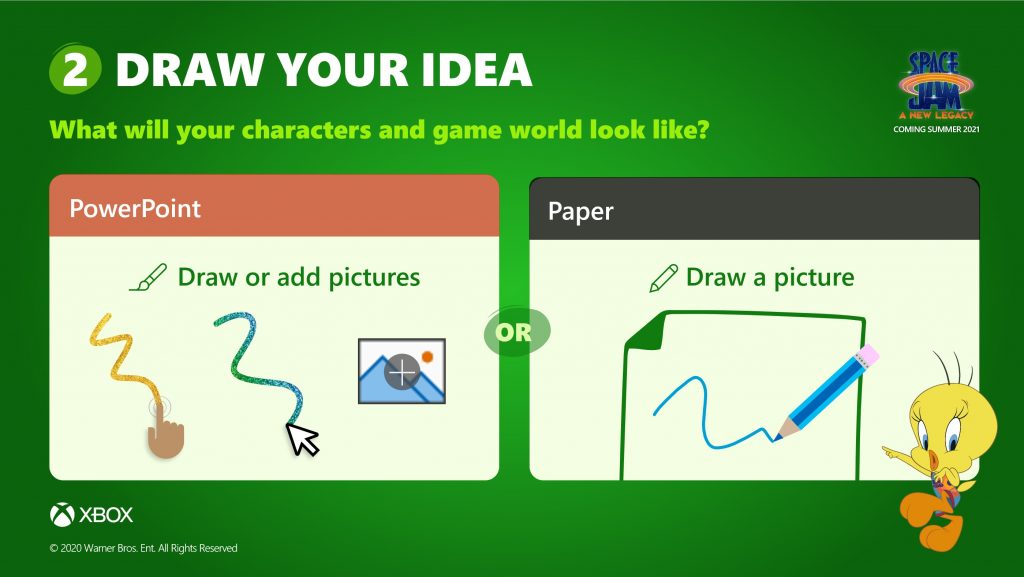 The Stores’ online workshops are aimed at younger learners – starting at about age 8 – and take them through a 90-minute Microsoft Teams Live lesson with a PowerPoint presentation that covers what makes a great video game, STEAM careers that are involved, and the skills needed for those jobs. Kids will find out about several roles vital to making a video game, including game developer, artist, executive producer, creative director and engineer. These lessons will run weekly through February.
The Stores’ online workshops are aimed at younger learners – starting at about age 8 – and take them through a 90-minute Microsoft Teams Live lesson with a PowerPoint presentation that covers what makes a great video game, STEAM careers that are involved, and the skills needed for those jobs. Kids will find out about several roles vital to making a video game, including game developer, artist, executive producer, creative director and engineer. These lessons will run weekly through February.
“We’re building a way that feels very engaging and interesting,” says Catriona Watson, who creates trainings and workshops for Microsoft Stores. “Common Core standards are also woven into the lessons.”
The Stores lessons will prompt attendees on building characters, plot, genre and title of games.
“One of the things we liked about this partnership is that it aligns with our goals of introducing computer science to kids who would not normally be interested in coding. But we know that most kids love video games, right?” says Jacqueline Russell, a program manager who works on MakeCode. “So if we can tie learning to code to games and creating your own video game, I think that’s super empowering for a lot of kids who play video games every day, but maybe never thought they could create their own.”
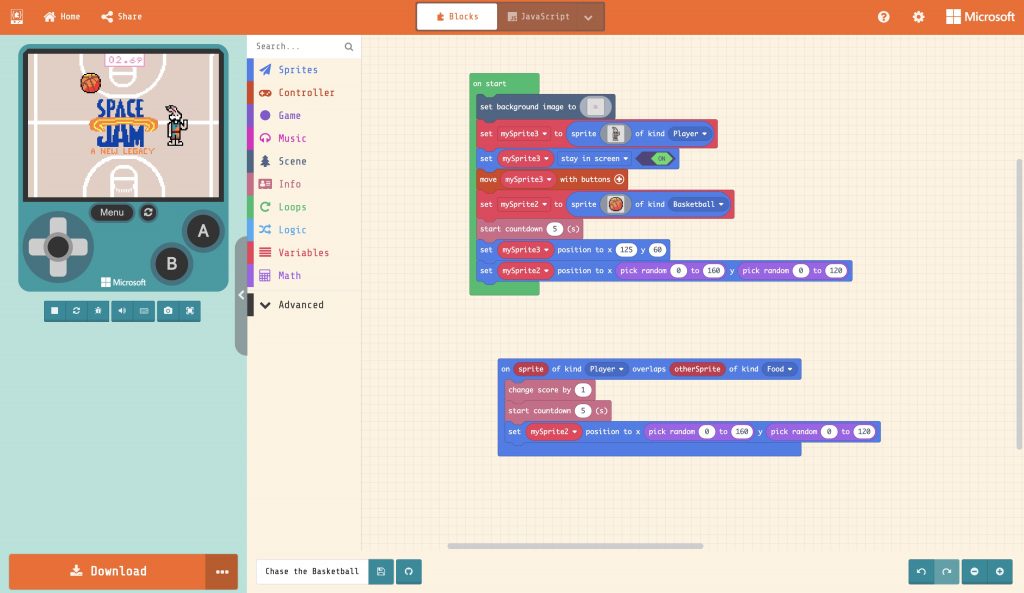 This leads to a half-hour section that focuses on hands-on the block-based coding. Kids will learn to code a game in which a character chases a basketball around the court and every time they get it, it’s randomly placed somewhere else, with a timer that runs wherever the object is placed. While it’s a generic game concept, it teaches good fundamentals.
This leads to a half-hour section that focuses on hands-on the block-based coding. Kids will learn to code a game in which a character chases a basketball around the court and every time they get it, it’s randomly placed somewhere else, with a timer that runs wherever the object is placed. While it’s a generic game concept, it teaches good fundamentals.
“The game building is browser based, so there’s nothing for students to download or install,” says Sonia Kandah, the designer working with Russell on the MakeCode part of the lessons. They use the Arcade platform, which uses blocks and drag and drop to help kids create the game. Through Arcade, blocks represent lines of code and coding concepts.
“I feel like kids have a lot of things thrown at them in their lives, and kids tend to have a little bit shorter attention span. So anything that you can do to kind of get them in the door helps bridge the gap and make kids more comfortable and more excited in the beginning,” Kandah says. “This is not some like weird thing where you have to code on a terminal machine in a dark basement. It’s very approachable.”
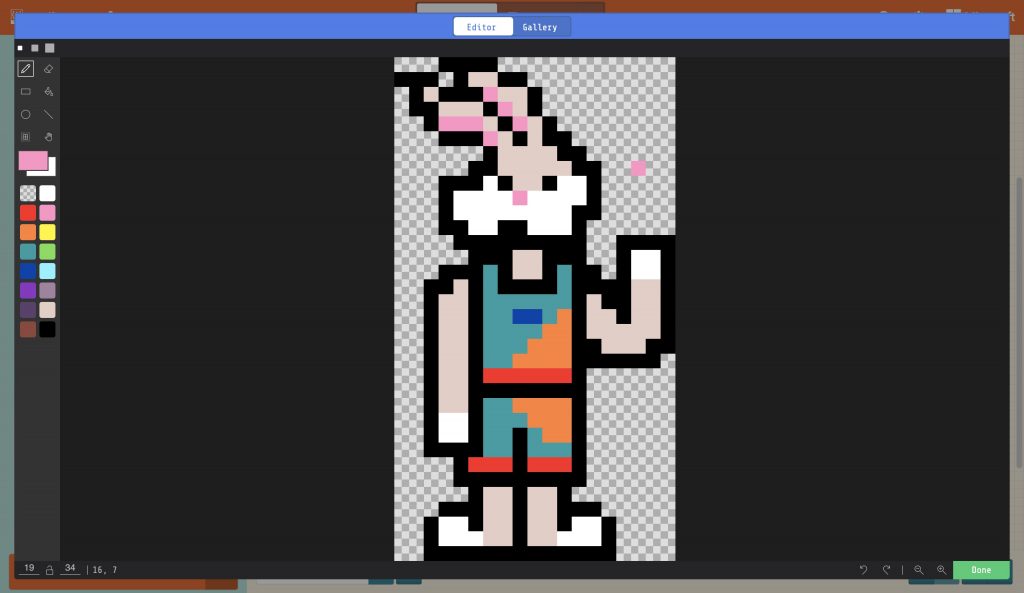 “The only limitation,” Kandah says, is that these are pixel-based 2D games. But “It’s very versatile and one of the really cool things is that you can make a game and then download it to a variety of different devices.”
“The only limitation,” Kandah says, is that these are pixel-based 2D games. But “It’s very versatile and one of the really cool things is that you can make a game and then download it to a variety of different devices.”
The last piece of the workshop focuses on what the kids have learned, and where to go from there.
“They have a section in the workbook where if they are interested in creativity, it tells them they could potentially be a video game designer,” Watson adds. “And if you’re interested in that, it’s good for you to continue to draw and pursue art. They can see that there is a pathway from what they are interested in and what they’re passionate about. If they continue being passionate about that and developing their skills in that area at a really basic level, this is the type of job that they could have.”
The final exercise tells them that through this workshop, they’ve persevered, problem solved and shown creativity. And it asks them to apply the social and emotional learning they’ve gained through STEAM-based activities to their lives.
The last section of the Stores workshop will include details on how to submit video game ideas inspired by “Space Jam: A New Legacy,” which may lead to the development of a real mini arcade-style video game timed to the film’s 2021 release. From Dec. 14 through Dec. 30, fans will be able to submit their game ideas at the official contest website.
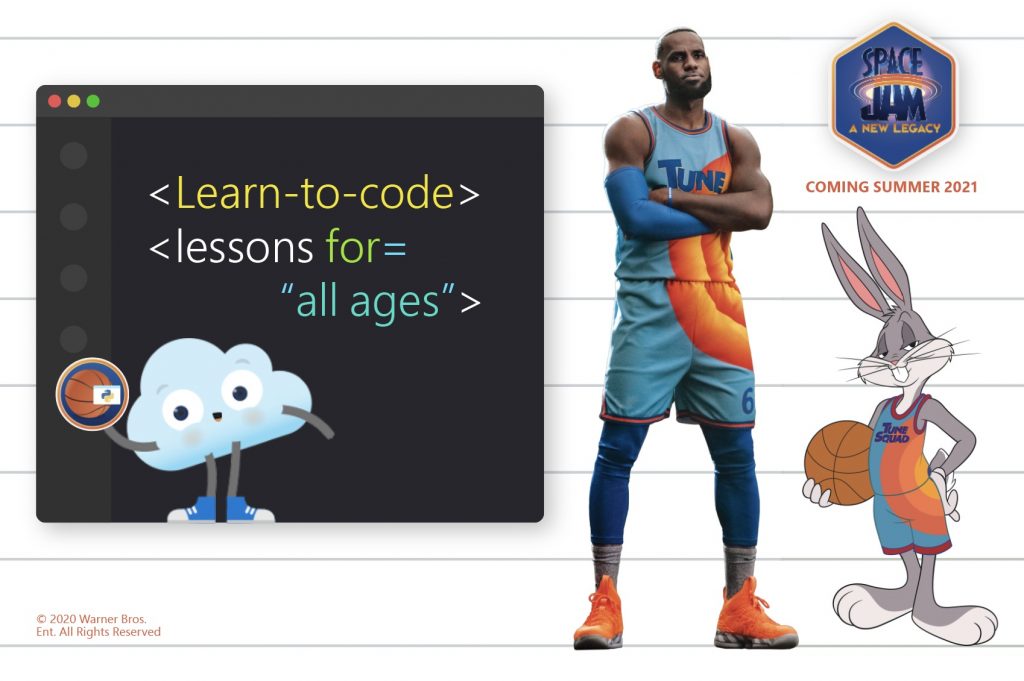 Microsoft Stores has also created an educator version of these film-themed workshops (broken into two 45-minute lessons) that will make it possible for teachers (for students ages 8 and up) to incorporate STEAM lessons in their curricula.
Microsoft Stores has also created an educator version of these film-themed workshops (broken into two 45-minute lessons) that will make it possible for teachers (for students ages 8 and up) to incorporate STEAM lessons in their curricula.
For more information on the new coding workshops, visit this What’s in Store blog post.
For older learners, Sarah Guthals, a principal program manager in Microsoft’s developer relations organization, built two Microsoft Learn lessons around using player stats to help a coach make real-time decisions in the middle of a game.
In basketball, you work together over an almost-100-foot court to control the ball, sink shots in a net, accumulate points and triumph over the other team. There’s a lot going on per player, per team; a dizzying array of stats that help the team figure out what’s going well and what to improve. There’s a wealth of information there that transfers well to more complex lessons.
In the first lesson Guthals created, learners are going to predict efficiency ratings with machine learning and Visual Studio Code, using data from human and Tune Squad basketball players.
In the second lesson, they’ll build a web app that uses additional machine learning models in real time to help a coach decide who needs a break at a certain point during a game and who should be put in the game to yield the highest likelihood of winning.
Through these modules, learners will explore and understand data from multiple sources, use machine learning to input missing data and integrate data created by a machine learning model into an app.
“We’re trying to stay very relevant to what people who care about basketball might care about, while also guiding learners through an introduction to the Python programming language, data science, machine learning and developing web applications,” says Guthals, who goes by Dr. G since she taught computer science at the university level (and has a Ph.D.). She builds content that includes learn modules as well as videos, and she uses different tools within Microsoft, such as Visual Studio Code and GitHub. She also grew up in Southern California and is a Lakers fan. “What I know is that context and themes and narratives that tie into technical education yield better transfer of that knowledge, so if someone can be passionate and excited about what they’re learning because of that contextual narrative, they’re more likely to persist through challenges. They are more likely to fully understand what they’re learning and why, and therefore they are more likely to be able to transfer that knowledge to new problems.”
There are instructions to set all of this up, and Guthals has also pre-recorded videos to walk through all the lessons, for additional support.
“My hope is that we can show people who already have this passion, that there are tools that can help them dive deeper into the passion they already care about,” Guthals says. “Tech is a tool that they can use to solve problems that they are already interested in.”

